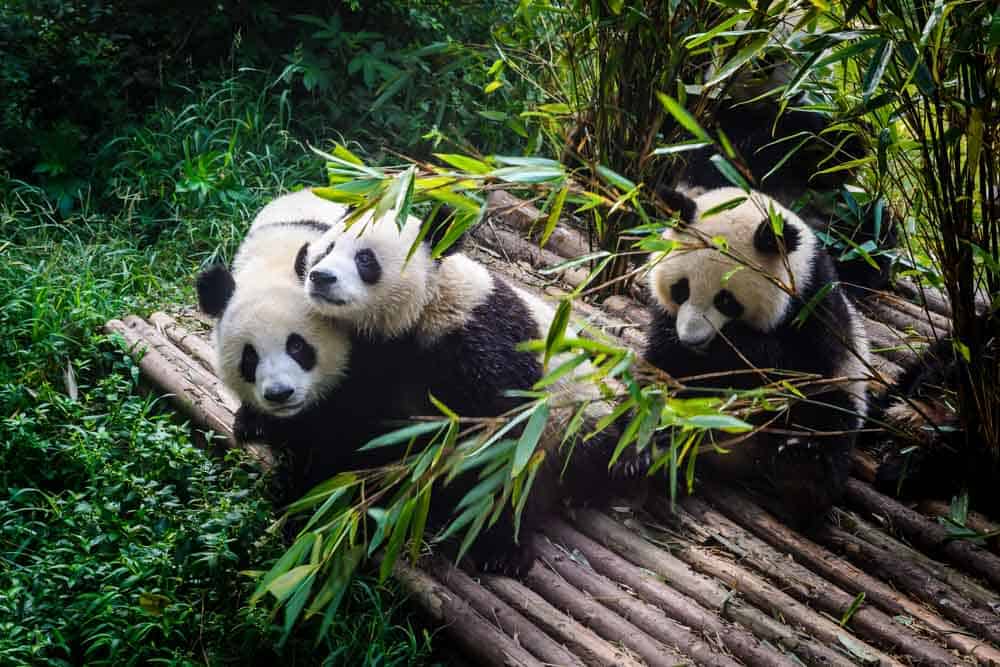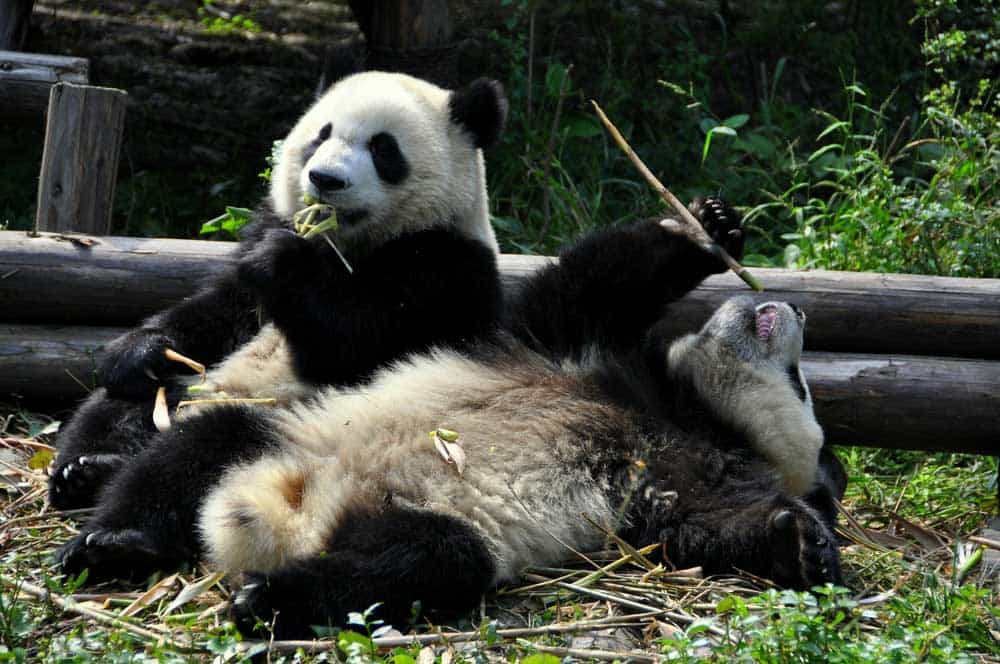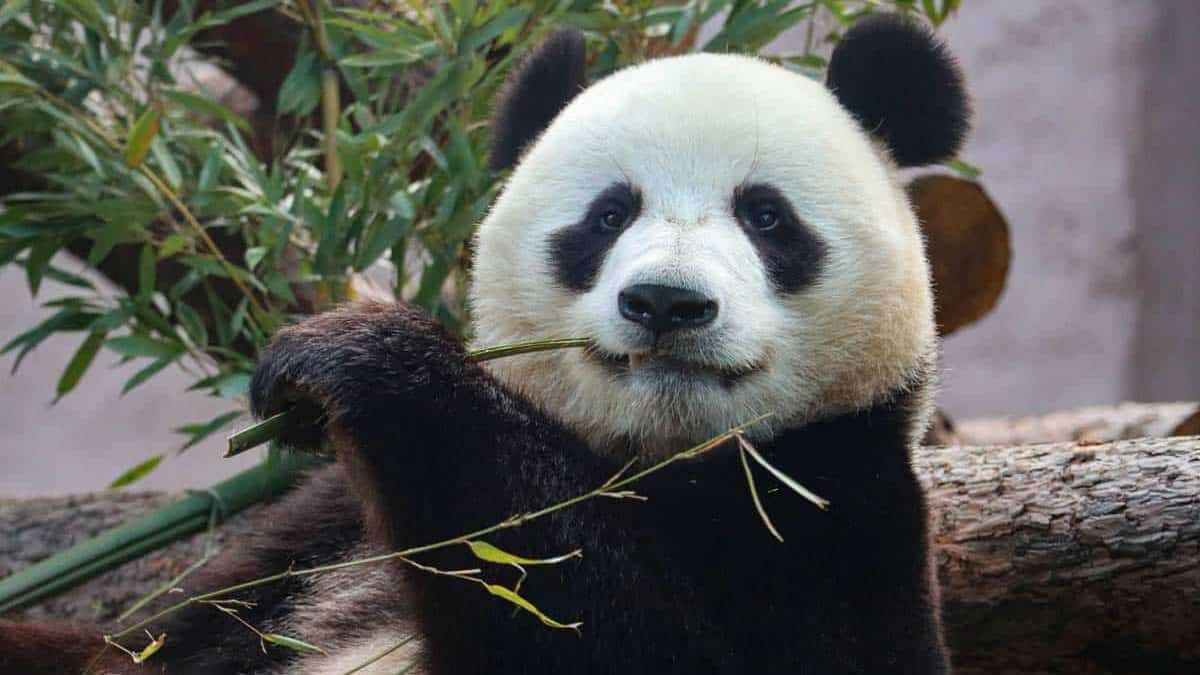If you are looking for information and giant panda facts, then this is the article for you!
Giant pandas are omnivorous mammals. Their scientific name is Ailuropoda melanoleuca. Giant pandas are widely known for their trademark black and white fur.
Native to Southwest China, this animal is seen as a symbol of good luck, peace, harmony, friendliness, and happiness in Chinese culture. Giant panda bears are considered sacred creatures, as they are the only mammal to have survived the Pleistocene (also known as the ice age) over three million years ago.
Whether you’re here for a school project on Giant Pandas, or just for fun, you will find information on Giant Pandas habitat, lifespan, diet, cubs, behaviour, their conservatory status, and what you can do to help giant pandas.
If you want your own giant panda at home, you can find cute giant panda plushies by clicking here!
10 Fun Facts about Giant Panda Bears
- Their black and white colouring serves two purposes: camouflage and communication. The panda’s face, belly, neck, and rump is white in order to help it camouflage in snowy habitats. The black fur on the bear’s arms and legs help it hide in the shade.
- Like domesticated cats, giant pandas have vertical slits for pupils. This is different compared to normal bears.
- A panda’s age can be determined by the distance between its nipples.
- Giant pandas are talented creatures. They’re capable swimmers and are excellent at climbing trees. Giant panda cubs learn to climb trees when they are as young as five months old- they often practice by climbing their mom first!
- Giant pandas have an extended wrist bone that works like thumb to humans, helping them to grab food. This means that they technically have six fingers.
- A panda year is the equivalent of three human years in terms of life expectancy. The world’s oldest giant panda was 38 years old and four months, living from 1982 to 2020 at Chongqing Zoo. Its name was Xinxing, meaning ‘new star’.
- China owns all the pandas in the world. They are considered national treasures, and are protected by law.
- Giant pandas have been World Wildlife (WWF)’s logo since they were founded in 1961. Chi-Chi, a panda living at the London Zoo the year that the organisation was founded was the inspiration behind the iconic logo.
- Despite their diet consisting mainly of bamboo and other vegetation, giant pandas actually have the digestive system and the teeth of a carnivore. It is believed by scientists that this species has evolved from eating animals to consuming a diet consisting of almost entirely bamboo around 2 million years ago.
- China has 67 panda nature reserves, which look after around 66% of the giant pandas in the wild, and 54% of their natural habitat.
Where do Giant Panda Bears live?

Giant pandas inhabit the temperate forests in the mountains of southwest China. Their primary habitat is the Yangtze Basin region in China. Historically, they used to inhabit a much broader range of China’s mountains but have now been restricted to only certain areas due to human infrastructure. A giant panda needs around at least 3-8 square kilometres of bamboo forest and at last two types of bamboo to survive.
How long do Pandas live for?
Giant pandas can live for up to 30 years in captivity, and 20-25 years in the wild. These mammals typically live more in captivity as they are protected from the environmental threats in their natural habitat. A giant panda is considered a fully grown adult at five years. A panda aged 1-5 years old is considered a teenager, 5-18 an adult, and 18+ an elder.
What do Giant Panda Bears eat?
It is widely known that panda’s main food source is bamboo. However, they require at least 2 different bamboo species in their range in order to avoid starvation. Besides bamboo, they also feast on other vegetation such as stems, shoots, roots, and leaves. Pandas also occasionally forage in farmlands for pumpkins, kidney beans, wheat, and domestic pig food. Giant pandas spend on average 10-16 hours a day feeding, but only digest about 1/5 of it!
Baby Giant Panda Bears
Giant panda babies are called cubs. The pregnancy period is typically anywhere between 95-165 days long. Cubs are born through live birth, as they are mammals. Giant pandas usually only have one cub at a time. If a giant panda has twins in the wild, it is likely that the mother will only care for and feed the one she deems strongest, abandoning the other one. This is because giant pandas don’t have enough milk or energy to care for two cubs.
Cubs generally start eating bamboo at around 12 months old but are dependent on their mothers until then. Giant panda cubs are born fur-less, pink-skinned, and blind. Their trademark black and white fur grows when they reach three weeks old. A newborn giant panda typically only weighs around 100 grams, which is only 1/900 of their mother’s weight. They’re typically around the size of a stick of butter. This is incredibly small when compared to human babies, that are born at 1/20 of their mother’s weight.
Click here to find some awesome giant panda shirts!
Giant Panda Subspecies

There are two giant panda subspecies: Sichuan giant pandas and Qinling giant pandas. The two subspecies are of the same origin, however palaeontologists estimate that they broke off contact 50,000 years ago due to the natural landmarks of their habitat, as well as human activity.
Giant Panda Bear Behaviour
Giant pandas are solitary creatures. In the wild, they have their own territory which they don’t allow other giant pandas to invade. This is likely because they don’t have to hunt co-operatively in packs or herds as their main food source is bamboo. Conflict over food would be likely to occur if giant pandas were to live in groups. They only come together for a short period of time during the mating season. Afterwards, the female raises the cub alone.
Unlike other types of bears, giant pandas do not hibernate. This is because their diet, consisting mainly of bamboo, prevents them from, storing enough fat to slumber through winter. Giant pandas typically sleep during the day and scavenge for food, such as bamboo, during the night. Humans have seldom been attacked by giant pandas, as this animal typically retreat, acting docile and submissive when running into humans. However, if a human goes near their cub, they are likely to become aggressive and attack.
Giant Panda Bears Conservatory Status
Giant pandas are currently listed as vulnerable. At the time of writing, their population in the wild is at 1,864, and 400 in captivity. The main threats that are affecting their population numbers are habitat loss and hunting. Infrastructure development such as dams, roads, and railways throughout their natural habitat separates and isolates the giant panda populations. This prevents them from accessing and finding new bamboo forests and potential mates.
Poaching for pandas has been made illegal under the enactment of the Wildlife Protection Act (1988), which enforces harsh punishments for hunting pandas. However, accidents still happen, and pandas are often getting caught in snares set for musk deer or other species.
Do you want notebooks with giant pandas? Click here to find some!
Ways to help Giant Pandas

After reading about their vulnerable conservatory status, as well as the many threats that risk their population, you might be wondering what you can do in order to help giant pandas and prevent them from going extinct. We have compiled a list of tips, tricks, and charities that you can contribute to below.
- Adopt a panda. WWF gives you the possibility to adopt a panda, offering different bundles costing different prices ranging between $25 to $250. The bundles offer different items ranging from adoption certificates, giant panda plushies, gift boxes, and gift bags. If you’re interested in checking this out, click here!
- Donate to charities that protect pandas, their rights, their habitats, and their food sources.
- Adapt ecotourism practices when travelling abroad. Global warming is detrimental to giant panda bears habitat and food sources. By reducing your travel impact and not travelling on transport that emits high levels of greenhouse gases, you can help save giant pandas habitats.
- Use less paper. As previously mentioned, giant pandas main food source is bamboo. Bamboo trees are becoming scarce as they are being cut down to make paper. By being mindful of the amount of paper you are using, and choosing to use recycled paper instead, you are helping save pandas from extinction.
Fun Facts for kids about Giant Panda Bears
From their habitat, to their cubs, and their behaviours, we hope you found this article with fun facts for kids about giant panda bears informative and joyful. If you’re looking for more fun facts about animals, people, places, history, or space, check out the list below!

